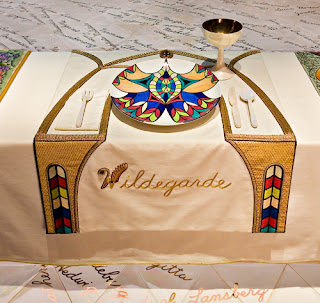Chicago's 1979 work The Dinner Party turned the male-dominated art world upside down, setting the table for 39 prominent and mythical women with vulva-inspired ceramic plates and elaborately embroidered place settings. “Women had embedded in houses for centuries and had quilted, sewed, baked, cooked, decorated and nested their creative energies away,” Chicago wrote in her 2006 book Through the Flower. “What would happen, we wondered, if women took those same homemaking activities and carried them to fantasy proportions?”
Chicago "reclaimed the feminine in the midst of our male-dominated art world" and "paved the way for subsequent generations of female artists," wrote Lucy Koto Olive in The Brooklyn Rail, adding, "The Dinner Party brought psychedelia and feminist ideas together in a bizarre, monumental manner. The many detailed settings, the symbolic triangular shape of the table, and the use of the vagina aim to grasp and elevate the universal feminine experience. In its totality and repeated attention to patterns and shapes, the psychedelic is strongly present in this work," Olive wrote.
When The Dinner Party opened at the San Francisco Museum of Modern Art, "no one had ever seen anything like it," wrote Sasha Weiss in the New York Times. "It was theatrical, audacious and definitively feminist: a work of stark symbolism and detailed scholarship, of elaborate ceramics and needlework that also nodded to the traditional amateurism of those forms, a communal project that was the realization of one woman’s uncompromisingly grand vision, inviting both awe and identification. It caused an immediate sensation."
Weiss interviewed Chicago for her 2018 article, describing here like this: "Her lipstick was purple, her curly hair dyed a reddish-pink, with tinted glasses to match, giving her a dreamy, psychedelic look."
 The 39 women symbolically seated at Chicago's table include the goddess Ishtar, who begins my book Tokin' Women. Also represented are Hildegarde von Bingen, who kept the flame alive in the Dark Ages; Emily Dickinson and Margaret Sanger.
The 39 women symbolically seated at Chicago's table include the goddess Ishtar, who begins my book Tokin' Women. Also represented are Hildegarde von Bingen, who kept the flame alive in the Dark Ages; Emily Dickinson and Margaret Sanger.
Among the 998 Goddesses, rulers, healers, artists, and persecuted women named in The Heritage Floor on which the dinner party sits are:
-Kore (Persephone), who, with her mother Demeter, was a goddess of the ancient Greek Eleusinian mysteries, with their drug kykeon.
- Circe, who used a drug to turn men to swine, and Helen of Troy, whose drug nepenthe soothed soldiers in Homer's tales.
- The goddesses Hera and Juno and an Amazon woman.
- The Biblical Makeda (Queen of Sheba), Jezebel, and Maacah, the daughter of the Biblical King David's son Absalom, who was removed her royal position by her grandson King Asa because she built an obscene memorial to the goddess Asherah.
- Military commander Joan of Arc, sociologist Harriet Martineau, spiritualist Helena Blavatsky, and anthropologist Margaret Mead.- Authors George Eliot, Isak Dinesen and Simone de Beauvoir, and author/art patron/salon hostess Gertrude Stein.
- Artist Frida Kahlo, jazz musician Mary Lou Williams, and dancer Josephine Baker. Womens' herstories had been long buried before Chicago helped smash through the centuries of silence with her powerful work. While—the artist points out—penis symbols are everywhere (sky scrapers, obelisks), she took so much criticism for depicting women's reproductive parts that she became suicidal.Seen by over 100,000 people in the three months it was first on display, The Dinner Party was bashed by critics as mere political rhetoric. A Los Angeles Times art critic cruelly called it “a lumbering mishmash of sleaze and cheese.” A tour of the show was canceled, with minimal explanation. Cancelled for a showing at the Brooklyn Museum of Art, the installation has now found a permanent home there, thanks to an endowment by Elizabeth Sackler (somewhat controversially, since the Sackler family has been criticized for its role in the opioid epidemic).
Chicago was a teacher of studio classes on feminist art, the first of their kind, at Fresno State College and CalArts in Valencia. "She pushed her students to create work based on consciousness-raising sessions in which they investigated their experiences as women, including being harassed by men," writes Weiss. Sadly, something that remains current.


No comments:
Post a Comment